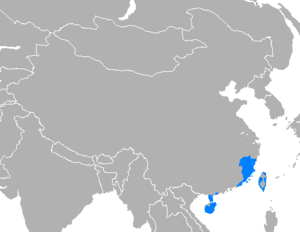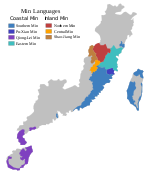|
Min ChineseMin (simplified Chinese: 闽语; traditional Chinese: 閩語; pinyin: Mǐnyǔ; Pe̍h-ōe-jī: Bân-gú / Bân-gír / Bân-gí / Mân-ú; BUC: Mìng-ngṳ̄) is a broad group of Sinitic languages with about 75 million native speakers. These languages are spoken in Fujian province as well as by the descendants of Min-speaking colonists on the Leizhou Peninsula and Hainan and by the assimilated natives of Chaoshan, parts of Zhongshan, three counties in southern Wenzhou, the Zhoushan archipelago, Taiwan[1] and scattered in pockets or sporadically across Hong Kong, Macau, and several countries in Southeast Asia, particularly Singapore, Malaysia, the Philippines, Indonesia, Thailand, Myanmar, Cambodia, Vietnam, Brunei. The name is derived from the Min River in Fujian, which is also the abbreviated name of Fujian Province. Min varieties are not mutually intelligible with one another nor with any other variety of Chinese (such as Mandarin, Cantonese, Wu, Gan, Xiang, or Hakka). There are many Min speakers among overseas Chinese in Southeast Asia. The most widely spoken variety of Min outside of mainland China is Hokkien, a variety of Southern Min which has its origin in southern Fujian. Amoy Hokkien is the prestige dialect of Hokkien in Fujian, while a majority of Taiwanese speak a dialect called Taiwanese Hokkien or simply Taiwanese. The majority of Chinese Singaporeans, Chinese Malaysians, Chinese Filipinos, Chinese Indonesians, Chinese Thais, Chinese Cambodians are of Southern Min-speaking background (particularly Hokkien and/or Teochew), although the rise of Mandarin has led to a decline in the use of Min Chinese. Communities speaking Eastern Min, Pu-Xian Min, Haklau Min, Leizhou Min, and Hainanese can also be found in parts of the Chinese diaspora, such as in Malaysia, Singapore, and Indonesia. Many Min languages have retained notable features of the Old Chinese language, and there is linguistic evidence that not all Min varieties are directly descended from Middle Chinese of the Sui–Tang dynasties. The Min languages are believed to have a significant linguistic substrate from the languages of the inhabitants of the region before its sinicization. HistoryThe Min homeland of Fujian was opened to Han Chinese settlement by the defeat of the Minyue state by the armies of Emperor Wu of Han in 110 BC.[4] The area features rugged mountainous terrain, with short rivers that flow into the South China Sea. Most subsequent migration from north to south China passed through the valleys of the Xiang and Gan rivers to the west, so that Min varieties have experienced less northern influence than other southern groups.[5] As a result, whereas most varieties of Chinese can be treated as derived from Middle Chinese—the language described by rhyme dictionaries such as the Qieyun (601 AD)—Min varieties contain traces of older distinctions.[6] Linguists estimate that the oldest layers of Min dialects diverged from the rest of Chinese around the time of the Han dynasty.[7][8] However, significant waves of migration from the North China Plain occurred:[9]
Jerry Norman identifies four main layers in the vocabulary of modern Min varieties:
Laurent Sagart (2008) disagrees with Norman and Mei Tsu-lin's analysis of an Austroasiatic substratum in Min.[15] The hypothesis proposed by Jerry Norman and Mei Tsu-lin arguing for an Austroasiatic homeland along the middle Yangtze has been largely abandoned in most circles and left unsupported by the majority of Austroasiatic specialists.[16] Rather, recent movements of analyzing archeological evidence, posit an Austronesian layer, rather than an Austroasiatic one.[17] Geographic location and subgrouping Min languages by number of native speakers (as of 2004)[18][page needed] Hokkien (41.6%) Eastern Min (13.9%) Hainanese (9.4%) Leizhou Min (6.2%) Pu-Xian Min (3.5%) Northern Min (3.5%) Shao-Jiang Min (1.2%) Central Min (0.9%) Datian Min (0.3%)
Min is usually described as one of seven or ten groups of varieties of Chinese but has greater dialectal diversity than any of the other groups. The varieties used in neighbouring counties, and in the mountains of western Fujian even in adjacent villages, are often mutually unintelligible.[19] Early classifications, such as those of Li Fang-Kuei in 1937 and Yuan Jiahua in 1960, divided Min into Northern and Southern subgroups.[20][21] However, in a 1963 report on a survey of Fujian, Pan Maoding and colleagues argued that the primary split was between inland and coastal groups. A key discriminator between the two groups is a group of words that have a lateral initial /l/ in coastal varieties, and a voiceless fricative /s/ or /ʃ/ in inland varieties, contrasting with another group having /l/ in both areas. Norman reconstructs these initials in Proto-Min as voiceless and voiced laterals that merged in coastal varieties.[21][22] Coastal MinThe coastal varieties have the vast majority of speakers, and have spread from their homeland in Fujian and eastern Guangdong to the islands of Taiwan and Hainan, to other coastal areas of southern China, and to Southeast Asia.[23] Pan and colleagues divided them into three groups:[24]
The Language Atlas of China (1987) distinguished two further groups, which had previously been included in Southern Min:[29]
Coastal varieties feature some uniquely Min vocabulary, including pronouns and negatives.[31] All but the Hainan dialects have complex tone sandhi systems.[32] Inland MinAlthough they have far fewer speakers, the inland varieties show much greater variation than the coastal ones.[33] Pan and colleagues divided the inland varieties into two groups:[24]
The Language Atlas of China (1987) included a further group:[29]
Although coastal varieties can be derived from a proto-language with four series of stops or affricates at each point of articulation (e.g. /t/, /tʰ/, /d/, and /dʱ/), inland varieties contain traces of two further series, which Norman termed "softened stops" due to their reflexes in some varieties.[35][36][37] Inland varieties use pronouns and negatives cognate with those in Hakka and Yue.[31] Inland varieties have little or no tone sandhi.[32] VocabularyMost Min vocabulary corresponds directly to cognates in other Chinese varieties, but there are also a significant number of distinctively Min words that may be traced back to proto-Min. In some cases a semantic shift has occurred in Min or the rest of Chinese:
Norman and Mei Tsu-lin have suggested an Austroasiatic origin for some Min words:
However, Norman and Mei Tsu-lin's suggestion is rejected by Laurent Sagart (2008),[15] with some linguists arguing that the Austroasiatic predecessor of the modern Vietnamese language originated in the mountainous region in Central Laos and Vietnam, rather than in the region north of the Red River delta.[50] In other cases, the origin of the Min word is obscure. Such words include: Writing systemWhen using Chinese characters to write a non-Mandarin form, a common practice is to use characters that correspond etymologically to the words being represented, and for words with no evident etymology, to either invent new characters or borrow characters for their sound or meaning.[53] Written Cantonese has carried this process out to the farthest extent of any non-Mandarin variety, to the extent that pure Cantonese vernacular can be unambiguously written using Chinese characters. Contrary to popular belief, a vernacular written in this fashion is not in general comprehensible to a Mandarin speaker, due to significant changes in grammar and vocabulary and the necessary use of a large number of non-Mandarin characters. For most Min varieties, a similar process has not taken place. For Hokkien, competing systems exist.[53] Given that Min combines the Chinese of several different periods and contains some non-Chinese substrate vocabulary, an author literate in Mandarin (or even Classical Chinese) may have trouble finding the appropriate Chinese characters for some Min vocabulary. In the case of Taiwanese, there are also indigenous words borrowed from Formosan languages (particularly for place names), as well as a substantial number of loan words from Japanese. The Min (Hokkien, Teochew, Hainanese, Luichow, Hinghwa, Hokchew, Hokchia, Haklau / Hai Lok Hong) spoken in Singapore, Malaysia, and Indonesia has borrowed heavily from Malay (or Indonesian for Indonesia) and, to a lesser extent, from Singaporean or Malaysian English and other languages. Meanwhile, the Hokkien spoken in the Philippines has also borrowed a few terms from Spanish, Tagalog (Filipino), and English over the recent centuries. In Kelantan Peranakan Hokkien, spoken in Kelantan state of Malaysia to Pattani province of Thailand, a mix of Southern Thai and Kelantan Malay is also used with the local Kelantan Hokkien of Peranakans and Chinese Malaysians in Northern Malaya. The result is that adapting Chinese characters to write Min requires a substantial effort to choose characters for a significant portion of the vocabulary. Other approaches to writing Min rely on romanization or phonetic systems such as Taiwanese Phonetic Symbols or historically during Japanese rule over Taiwan, Taiwanese kana was also used for Taiwanese Hokkien in some Taiwanese-Japanese dictionaries made during that time. Since 1987, Taiwanese Hangul also exists for Taiwanese Hokkien. Some Min speakers use the Church Romanization (simplified Chinese: 教会罗马字; traditional Chinese: 教會羅馬字; pinyin: Jiàohuì Luómǎzì; Pe̍h-ōe-jī: Kàu-hoē Lô-má-jī). For Hokkien the romanization is called Pe̍h-ōe-jī (POJ), for Fuzhounese it is called Foochow Romanized (Bàng-uâ-cê, BUC), for Putian dialect it is called Hinghwa Romanized (Hing-hua̍ Báⁿ-uā-ci̍), for Jian'ou dialect it is called Kienning Colloquial Romanized (Gṳ̿ing-nǎing Lô̤-mǎ-cī), for Hainanese it is called Bǽh-oe-tu (BOT). These systems were developed by British, Irish, Danish, and American Protestant Christian missionaries over the course of the 19th century. In 2006, Tâi-lô (Tâi-uân Lô-má-jī Phing-im Hong-àn) which was derived from Pe̍h-ōe-jī (POJ) was officially promoted by Taiwan's Ministry of Education (MOE). Some publications use mixed writing, with mostly Chinese characters but using the Latin alphabet to represent words that cannot easily be represented by Chinese characters. In Taiwan, a mix of Chinese characters and Latin letters written in Pe̍h-ōe-jī (POJ) or Tâi-lô has recently been practised. In Singapore, Malaysia, the Philippines, and Indonesia, some also occasionally write Hokkien and/or Teochew using Latin letters via ad-hoc means using the writer's knowledge of the local mainstream orthography they grew up being literate in, such as Singaporean or Malaysian English orthography (descended from British English), Malay orthography / Indonesian orthography, Mandarin Pinyin for those in Singapore, Malaysia, and Indonesia, then Philippine English orthography (descended from American English), Filipino orthography, Mandarin Pinyin, and sometimes Spanish orthography (for older writings), for those in the Philippines. See alsoNotesReferencesCitations
Works cited
Further reading Minnan edition of Wikipedia, the free encyclopedia Mindong edition of Wikipedia, the free encyclopedia |



